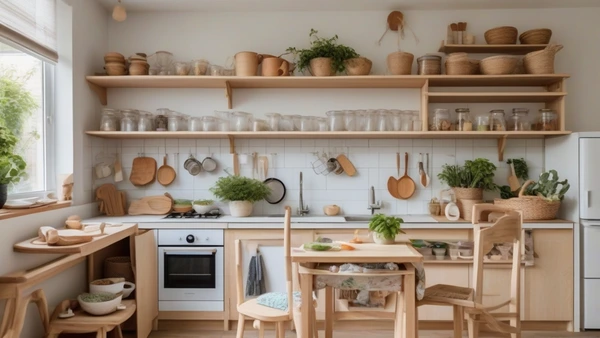Here are five simple steps to transform your kitchen into a sustainable haven.
We’re talking practical zero waste kitchen tips that anyone can implement, even with a busy schedule, because taking care of our planet should be simple and accessible for everyone.
Video Transcript
Welcome to Green Foot Mama!
Today, let’s look at some simple steps you can take toward a zero-waste kitchen.
When you start thinking about making your home more eco-friendly, the kitchen is a natural place to start. I mean, it’s the heart of the home, right? It’s where we nourish our families and create memories, but it can also be a place where a lot of waste occurs.
Today, let’s look at five simple steps to transform your kitchen into a sustainable haven. We’re talking practical tips that anyone can implement, even with a busy schedule, because taking care of our planet should be simple and accessible for everyone.
So grab your mason jars and your can-do spirit, and let’s get started!
1. Declutter First – Less is More
First things first: declutter. It’s the foundation of any successful kitchen makeover. Just like when we tackle any room makeover, we’re going to start by clearing out the clutter. This means taking a good, hard look at everything in your kitchen. That includes those gadgets we never use, mismatched containers, and anything that has seen better days.
It’s amazing how much space these items can take up!
I know letting go can be tough—it’s not just about the physical items. It’s about the memories and the “what ifs.”
I used to be one who held on to things just in case; you never know when you might need that old blender, right?
But trust me, letting go of what we don’t use frees up so much space, both physically and mentally—it’s like a weight lifted off your shoulders. I was able to get rid of seven, count them, seven appliances, and it felt so liberating. And you know what? I haven’t missed a single one!
My kitchen feels so much more open and inviting now.
When it comes to appliances, quality over quantity is key. A few reliable tools can make all the difference. Invest in a few workhorses that will stand the test of time.
For me, that was my trusty Thermomix; it’s a game changer in the kitchen! It blends, chops, cooks, and even makes bread—it’s like having a sous-chef right on your counter. Find what works for you and your family; every household is different, so tailor your kitchen to your needs.
And don’t forget about those plastic containers—they can be a real headache if not managed properly. We’ve all got a drawer full of mismatched lids and bottoms.
It’s time to sort through them. Let’s aim for a matching set of glass containers. They’re more durable and eco-friendly, better for storing food, and they look so much prettier in our pantries. Plus, they help keep everything organized.
Remember, one person’s trash is another’s treasure; your unused items could be a blessing to someone else. Let’s donate or responsibly recycle what we no longer need—it’s a win-win for you and the environment.
2. Kiss Those Plastics Goodbye!
All right, let’s talk plastics. They’re a huge part of our daily lives, especially in the kitchen. From containers to utensils, plastics are everywhere, but guess what? We can definitely cut back and make a big difference.
Start by swapping out plastic wrap for reusable options like beeswax wraps. These wraps are not only eco-friendly but also keep your food fresh. Alternatively, simply use a plate to cover leftovers—it’s an easy switch.
When it comes to food storage, glass is the way to go. Glass containers are durable, non-toxic, and don’t absorb odors or stains. I love my Lock & Lock glass containers—they’re airtight, stackable, and come with a handy replacement warranty. Plus, they look great in any kitchen.
Here’s a little tip I learned along the way: buy food in glass jars whenever possible.
It’s a small change that can make a big impact. Not only is it better for the environment, but you end up with a collection of beautiful jars that you can repurpose in so many ways. Use them for storage, as vases, or even for DIY projects.
Is Biodegradable Plastic Better?
Now, I know what you might be thinking: what about biodegradable plastics? They sound like a great alternative, right?
Well, it turns out they’re not always the eco-friendly option we thought they were. They often require specific conditions to break down properly, and sometimes they don’t decompose at all, leaving us with the same problem we started with. It’s a bit of a letdown, isn’t it?
So, let’s stick with reusable and durable options that will last us a lifetime. Metal straws, cloth bags, and durable kitchenware like glass and metal containers are fantastic choices.
Our planet will thank us for it!
By making these small changes, we contribute to a healthier Earth and a more sustainable future for generations to come.
3. Pantry Refresh – Organized and Eco-Friendly
I don’t know about you, but my pantry used to be a bit of a disaster zone. It was a place where things went to disappear, and finding anything was like going on a treasure hunt—cans stacked precariously, expired spices hiding in the back, and random items that I didn’t even remember buying.
Sound familiar?
But when I decided to give my kitchen a zero-waste makeover, I knew the pantry needed some serious love. It was time to transform this chaotic space into an organized, eco-friendly haven.
The first step was emptying everything out—and I mean everything. Every box, every spice jar. It was a bit overwhelming at first, but it felt so good to start with a clean slate.
Seeing those empty shelves gave me a sense of possibility. It was like looking at a blank canvas ready to be transformed into something beautiful and functional. I tossed out anything that was expired and took stock of what I actually had.
It was surprising to see how much food had gone unnoticed and unused.
Next, I gave the shelves a good wipe down and lined them with some pretty shelf paper. This not only made the pantry look nicer but also protected the shelves from spills and stains—just a little touch to make it feel more organized and inviting. It’s amazing how something as simple as paper can make such a big difference.
Then came the fun part: reorganizing.
I started by grouping similar items together, which made it easier to find what I needed. I like to group similar items together, so all my baking supplies go in one area, spices in another, and so on. This way, everything has its place. It’s not just about looking good; it’s about making the space functional and efficient. When everything is in its place, cooking and baking become so much easier and more enjoyable.
To avoid waste, I started using clear containers to store bulk ingredients like flour, sugar, and grains. These containers not only keep things fresh, but also make it easy to see what I have. This way, I can easily avoid buying more than I need. Plus, it looks so much more organized and visually appealing.
A well-organized pantry not only saves time and money, but also reduces stress—it’s a win-win!
4. From Pre-Packaged to Homemade Goodness
Now, let’s talk about one of the biggest culprits of waste in our kitchens: prepackaged foods.
From individually wrapped snacks to single-serving meals, it’s amazing how much packaging we accumulate.
But here’s the good news: cooking from scratch doesn’t have to be complicated or time-consuming. With a little planning and some simple recipes, we can drastically reduce our reliance on prepackaged foods. Start with one meal a week and gradually work your way up.
I promise it gets easier with practice, plus you’ll be amazed at how much better your food tastes when it’s made with fresh, whole ingredients.
Another way to reduce packaging is to buy in bulk whenever possible. Things like grains, beans, nuts, and spices can all be purchased in bulk, saving you money and reducing packaging waste. And when you do need to buy packaged goods, opt for items in glass or metal containers that can be reused or recycled.
5. Freezer Meals – A Busy Mama’s Best Friend
I’m all about finding ways to make life easier, and freezer meals have been a game changer for my family. They’re perfect for those busy weeknights when you don’t have time to cook a big meal from scratch.
The key to successful freezer meals is to cook in large batches—double or even triple your favorite recipes and freeze half for later.
I like to use glass containers for freezing meals, but you can also use freezer-safe bags. Just be sure to label everything clearly with the date so you know what’s what.
Some of my go-to freezer meals include soups, stews, casseroles, and even breakfast burritos—they’re all easy to reheat and taste just as good, if not better, the second time around. Having a freezer stocked with homemade meals is a lifesaver on those hectic days, plus it’s a great way to reduce food waste and ensure your family is always eating healthy, home-cooked meals.
Zero Waste Living – One Step at a Time
Well, there you have it! Five simple steps to transform your kitchen into a more sustainable and eco-friendly space.
Remember, it’s not about being perfect, but about making small changes that add up to a big difference over time.
Every time you choose to reuse a container, buy in bulk, or cook a meal from scratch, you’re making a conscious choice to reduce your impact on the planet—and that’s something to be genuinely proud of.
I’d love to hear your thoughts and ideas in the comments below. What are some of your favorite ways to reduce waste in the kitchen? Let’s inspire each other on this journey toward a healthier planet. See you next time!


